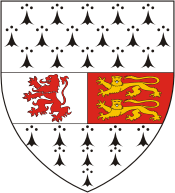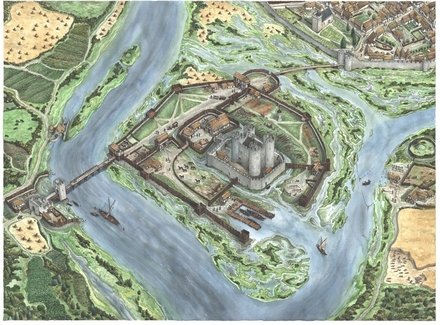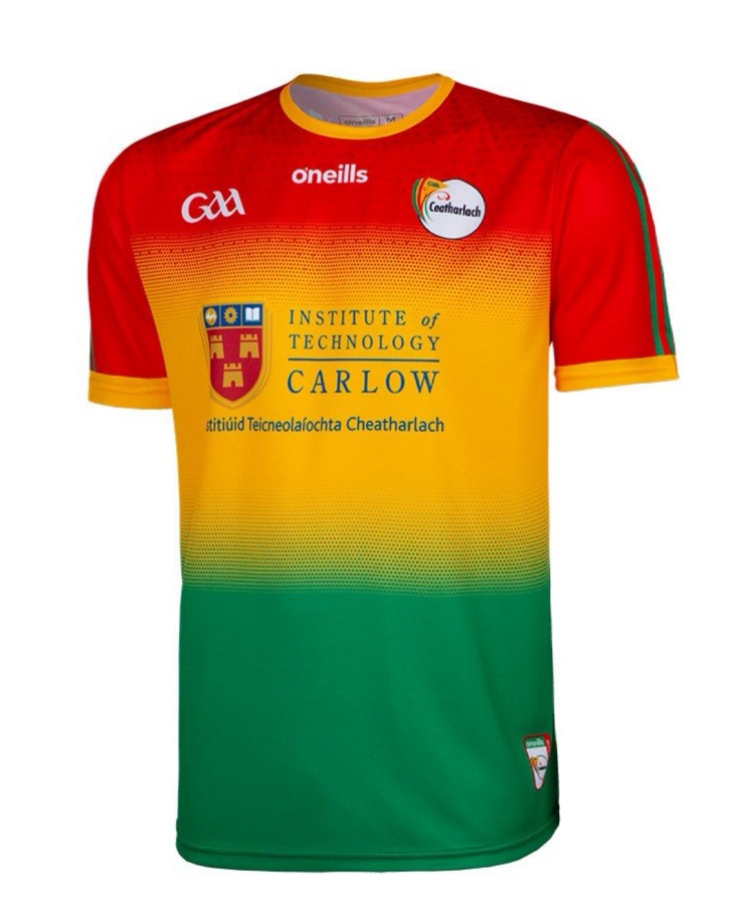Carlow – Catherloch – Ceatharlach

Origin/meaning of Carlow County Arms
The arms have strong associations with the Butler family. The two English lions signify that the Butlers held their land from the English crown. The rampant lion comes from the arms of another Butler family from Garrybunden in the county.
Motto: County Carlow does not have an official motto. It is the only Irish county without an official motto.
County Carlow (Contae Cheatharlach in the Gaelic language) is the second smallest county in Ireland with a population of 56,932 (census 2016) and measures 896 square kilometres in area. The county is a landlocked county and is situated in the South East of Ireland in the Province of Leinster, in Ireland’s Ancient East tourist trail. Its principal town of the same name is built on the river Barrow while the county also hosts the river Slaney that flows through the town of Tullow and southbound to Wexford. Other significant towns in the county include Tullow, Bagenalstown (Muine Bheag), Borris, Hacketstown, Leighlinbridge, and Rathvilly.
County Carlow has a large number of ancient monuments, including Brownshill Dolmen which is the largest Portal Dolmen in Europe and recognised as one of the finest prehistoric monuments in the country. Other historic and heritage sites include Carlow Castle, Borris House and Viaduct, Altamont House and Gardens, the Barrow Valley and St. Mullins Monastic Site, Duckett’s Grove Gothic Mansion and Walled Gardens, Lisnavagh House, Huntington Castle, and Haroldstown Portal Dolmen. In addition, several burial grounds of famous people such as Irish International Impressionist Artist Frank O’ Meara and the ancestors of Walt Disney are to be found in the county.
First settlements in County Carlow
Settlement in County Carlow pre-dates written history with notable prehistoric sites and monastic settlements including Brownshill Dolmen megalithic portal burial site, Friarstown, St. Mullins monastic settlement, Old Leighlin, St. Comhgall and St. Mary’s Abbey.
County Carlow may be the second smallest county in Ireland, but in this small county you will find many incredible historic and heritage sites.

Main town and villages in County Carlow 
Location of County Carlow
Origins of the name “Carlow” Catherloch
“Cath-er-loch” – translated from ancient Gaelic of “Stone-on-lake”
The county name of Carlow; originally “ Catherloch ” meaning “stone” or “rock” on a “lake” or “loch” (Cath-er-loch) in the ancient Gaelic language.
The words “Cath” meaning “Stone” in ancient Gaelic and the word “loch” meaning “Lake” gave rise to the name “ Cath-er-loch ”. This ancient Gaelic name was unpronounceable to the British, and in an attempt by the British to pronounce it, the name “Ca-r-low” – Carlow was born. The near demise of the ancient Gaelic language and the attempt to revive it, brought about the contemporary Gaelic language that we know today across the Island of Ireland. Today, “ Cath-er-loch ” translates to “Carlow” and re-translates to what is now known as Ceatharlach in contemporary Gaelic language. However, the translation to “four lakes” is without foundation. There are no known archaeological, topographical or historical records in existence of four lakes in the county of Carlow.
Where was the “Stone” or “Rock” on the lake?
Carlow Castle, built circa 1205, was completed in circa 1209. Built with no foundation on a large stone/rock island surrounded by marshland and a lough “lake” where the rivers Burren and Barrow meet, proved one of the greatest defensive structures. Hence, “ Cath-er-loch” – “stone-on-lake” – Ca-r-low (now called Ceatharlach).
To picture what this was like in the 1200s anyone who visits Carlow is encouraged to visit Castle Street (known to some as “Castle Hill”. Standing on the brow of the decline at the Tavern Pub, facing Carlow Castle in the West, it is clear to see the hollow of what was once a “lough” or lake. The River Burren is to the left, the River Barrow to the right and Carlow Castle is surrounded by a marshy “lough”. Over many years, this natural marsh land hollow has caused flooding in this area.

Carlow Town Established
William Marshal succeeded Strongbow, the Norman conqueror of Leinster as Lord of Leinster. He apparently commenced building Carlow castle in 1205 and it was completed circa 1209. Sited on a small island on the confluence of the rivers Barrow and Burren, the castle protected the river crossing and the town of Carlow. The castle was surrounded on three sides by water while the area of marshland restricted access from the fourth side.
William Marshal had established a town at Carlow about this time and hoped to use the river Barrow to provide a trade route with the prospering town down river at New Ross. At the beginning of the 14th century, the castle came under direct control of the English crown. In 1361, in an early form of decentralisation, Carlow was chosen as the new seat of government in Ireland and the exchequer was located at the castle until 1394.
Over the years, County Carlow has been given other names of association such as “The Dolmen County” due to Brownshill Dolmen which is the largest portal Dolmen in Europe. The people of County Carlow have also been given nicknames such as “Carlovians” and “The Scallion Eaters” pronounced “The ScallionAters”
“The ScallionAters”
The following is an extract from an article printed in The Irish Times dated June 1st 1934.
“A hundred acres of land about Carlow are parcelled out in two and three-acre pieces to a number of cottagers, who supply Dublin and most of Leinster with onions. The people are well clothed, in comfortable habitations, and, if their industry was generally practised, the cry of poverty of the Irish peasant would soon cease. The grower of onions divides his garden into quarters, the succession being onions, potatoes, barley and clover. He puts all the manure he can get on his onions, and he prefers street scrapings to all other. Here is industry, here is exertion; no price will stop the onion-grower in the purchase of manure.”
The Carlow onions may be things of the past, but in Ireland the nickname inspired by those crops of long ago will never die.”
Other information about the County
GAA colours:
Green, red and yellow.

Common Carlow Surnames:
Farrell, Kinsella, Lawlor/Lawler/Lalor, McDonald/McDonnell/McDonnoll, Doyle, Murphy, Nolan, Kavanagh, Walsh/Walshe
Famous people and/or their Carlow ancestry:
Walt Disney (Disney World), Frank O’Meara (Impressionist artist), Arthur MacMurrough-Kavanagh (Politician), Saoirse Ronan (Actress), Catherine Thomas (TV Presenter), Patrick and Emmet Bergin (Actors), Michael Flatley (Irish Dancer – River dance), Mary Kennedy (TV Presenter), Olivia O’Leary (TV Journalist and broadcaster), Willie Mullins (Horse trainer), John Tyndall (scientist) and many more…….